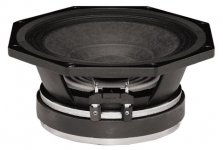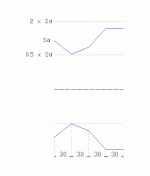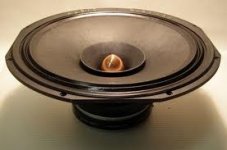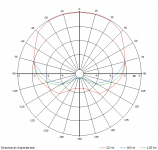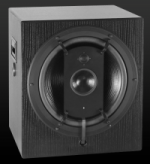John Krutke/Zaph reports airflow issues leading to audible distortion on his site with some Tang Band woofers. I don't remember the model numbers but it was the ones with the underhung motor ie huge magnets relative to driver size.
You mean like the W4-1720?
Member
Joined 2009
Paid Member
the engine valves only restrict flow at high revs, when a large amount of air is being moved, is it really an issue with most drivers? I suspect reflections are much more of an issue - although I'd say they don't count as box colourations. I think plante10 and others have used 'tricks' to minimize magnet reflections in the past ?
so, not comments on LARGE vent behind drivers to minimize reflections ?
so, not comments on LARGE vent behind drivers to minimize reflections ?
the engine valves only restrict flow at high revs, when a large amount of air is being moved, is it really an issue with most drivers? I suspect reflections are much more of an issue - although I'd say they don't count as box colourations. I think plante10 and others have used 'tricks' to minimize magnet reflections in the past ?
so, not comments on LARGE vent behind drivers to minimize reflections ?
I wonder why more drivers aren't made like this:
Attachments
I wonder why more drivers aren't made like this:
Because it is expensive.
dave
Because it is expensive.
dave
Oh, the neo yeah.
Maybe someday they'll find a super massive deposit somewhere and drop the prices by 10x :S
I was wondering about a restrictive magnet producing a horn throat and I created an example using the B&C 8PE21 8" mid.
The blue lines show the cross sectional area from the cone and around the magnet. Starting from the left with the cone area of 220cm^2, the next step is the basket cutouts converted to an equivalent circular cross section. The third step is the box area minus the magnet area, where the box is the smallest square box the driver cutout could fit, converted to circular cross section. From there is the box itself.
The blue lines show the cross sectional area from the cone and around the magnet. Starting from the left with the cone area of 220cm^2, the next step is the basket cutouts converted to an equivalent circular cross section. The third step is the box area minus the magnet area, where the box is the smallest square box the driver cutout could fit, converted to circular cross section. From there is the box itself.
Attachments
Member
Joined 2009
Paid Member
I'm going to be trying a BD BD15 as a dipole mid in place of my current setup with dual 6.5"s (Ceramic/Neo hybrid... with motors a lot like the B&C above), for the very reason above- the cone is minimally obstructed on the back relative to the front. Additionally the 15" has equivalent efficiency but an octave lower Fs and somewhere near 10dB more clean output and a smoother top end breakup (not that it matters with a 1k filter)
This is for 250-1kHz.
BD-Design' BD15
This is for 250-1kHz.
BD-Design' BD15
Magnet size or diameter is no primary factor in frequency response differences between front and rear of a dipole driver. As Siegfried Linkwitz has stated for years at Models for a dipole loudspeaker design, it is the "acoustic filter formed by the basket openings and trapped air between cone and basket". Together with the spider they build up a cavity, which acts as a Helmholtz resonator.
An open basket is better than wide braces, a small spider is better than a wide one, and a deep cone is better than a flat cone.
Rudolf
An open basket is better than wide braces, a small spider is better than a wide one, and a deep cone is better than a flat cone.
Rudolf
Member
Joined 2009
Paid Member
so bigger is better afterall when it comes to drivers - as it generally provides a more open space behind the cone.
not to beat a dead horse, but I'm still curious about opinions on the use of a large hole behind the driver for reducing colourations that arise from reflections off the back wall of the box, only the hole is designed so that it also acts as a reflex port. What are the pitfalls as opposed to a reflex vent somewhere else in the box ?
not to beat a dead horse, but I'm still curious about opinions on the use of a large hole behind the driver for reducing colourations that arise from reflections off the back wall of the box, only the hole is designed so that it also acts as a reflex port. What are the pitfalls as opposed to a reflex vent somewhere else in the box ?
A large hole in the back of the box is no different than any tuned pipe TL. The open end causes an out of phase reflection. This causes 1/4 wave (and multiples) resonances.
Either an opening or a hard surface both lead to reflections, just of opposite polarities. If you want the back of the cone mid output not to cause issues then you should absorb it with proper stuffing.
A properly stuffed sealed box will always deal better with the back wave energy.
Either an opening or a hard surface both lead to reflections, just of opposite polarities. If you want the back of the cone mid output not to cause issues then you should absorb it with proper stuffing.
A properly stuffed sealed box will always deal better with the back wave energy.
I was re-reading Olson and some comments made by US Enclosure and it occurred to me that the rear edges of the cabinet are also quite important. I have never dealt with that. So, as my speakers are still in the fab stage, applied the 3/4 inch rounderover to the back 4 edges. Now all 12 edges are eased. Sure enough, small improvement in midrange ripple. No where like the front, but both measurable and audible. I still have a little internal reflection to deal with and ordered 4 kinds of stuffing to compare. I ordered both the felt and ScanSpeak foam tweeter doughnuts to see their effect. I know what 1/2 inch felt does, but no idea if 1/8 does anything useful.
Magnet size or diameter is no primary factor in frequency response differences between front and rear of a dipole driver. As Siegfried Linkwitz has stated for years at Models for a dipole loudspeaker design, it is the "acoustic filter formed by the basket openings and trapped air between cone and basket". Together with the spider they build up a cavity, which acts as a Helmholtz resonator.
An open basket is better than wide braces, a small spider is better than a wide one, and a deep cone is better than a flat cone.
Rudolf
But magnet size is a key determiner, of the basket's openings and trapped air. Some spiders are more reflective than others but the magnet size is definitely a key factor.
Member
Joined 2009
Paid Member
Here is a speaker with 2 large holes in the back:
RL 901K
It produces a nice cardioid response at 32Hz somehow but that is all I know about it.
Interesting - yes this is what I'm talking about in terms of another technique that may influence box/room colourations.
In the case of the RL 901k it appears they went for back-wave in the bass to optimize room behaviour.
Attachments
I've been considering a woofer on the base panel to do this for the lower floor reflections. Something like the helper woofer(s, flanking subs) which I'm using. But while those will fix the region on axis, it's hard to find the perfect place where the remaining power goes to good effect as well. I figure these could remove an even slice of upper bass power, before it can turn into an uneven one.
It works for me so you might have to google 'ME Geithain' to get there.
Their distortion figures (around 0.25% at 96dBSPL) and FR (better than +-2dB) look pretty good too!
Their distortion figures (around 0.25% at 96dBSPL) and FR (better than +-2dB) look pretty good too!
Member
Joined 2009
Paid Member
I'm not seeing very much information from their descriptions though, not sure that this, after all, is anything interesting. There are no photos of the rear side, but the text says it is try-amped active and the electronics are on the backside. With this much electronics, it would be surprising if it wasn't a flat FR.
I suspect what they are talking about is actually baffle step (2pi to 4pi transition) dressed up in BS ?
As for box colourations, this link looks more interesting... http://www.6moons.com/industryfeatures/rondo/rondo.html
I suspect what they are talking about is actually baffle step (2pi to 4pi transition) dressed up in BS ?
As for box colourations, this link looks more interesting... http://www.6moons.com/industryfeatures/rondo/rondo.html
Attachments
Last edited:
- Home
- Loudspeakers
- Multi-Way
- Box colourations - really ?

